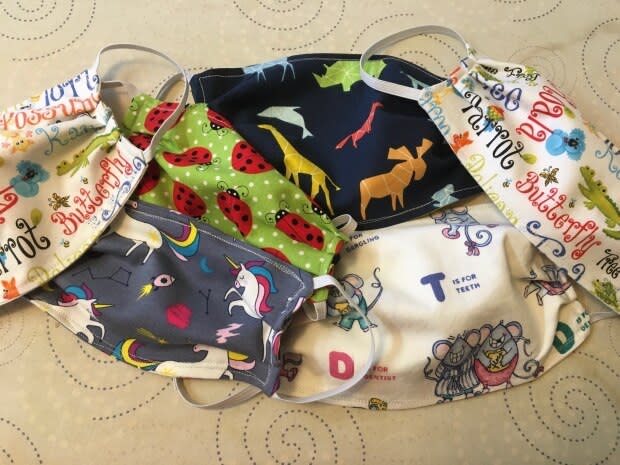Edmontonians embracing non-medical masks
According to Health Canada, non-medical masks "may not be effective in blocking virus particles" and do not provide complete protection from COVID-19, but that hasn't stopped many Edmontonians from sourcing their own supplies or dusting off their sewing machines to make their own.
Once discouraged, wearing these masks is now permitted by Dr. Theresa Tam, Canada's chief public health officer.
While not without limitations, wearing a non-medical mask is an additional measure people can take to protect others, Tam said in a Monday news conference. She added that Canadians can make their own out of readily-available materials like cotton shirts, sheets and bandanas.

Multi-coloured non-medical masks are now ubiquitous in Edmonton grocery stores and other places people gather.
It turns out they're not all that hard to make.
"I went onto YouTube and I found some good instructional videos and I just started making them," said Edmonton resident Phoebe Rush, who makes hers out of quilting cotton and flannel. Each one takes her about 10 minutes to produce.
Local businesses, in a variety of industries, are firing up their sewing machines too.
Landon Derk, vice-president of Derks Formals (part of the Derks Fine Group of Companies), said his company has already received about 4,000 orders for their reusable cotton masks.
The company bought more machines and added four people to its production line to be able to produce more of them.
What makes some homemade masks better than others?
Layers are the key to a better homemade mask, according to Jason Tetro, an Edmonton microbiologist and author.
"What you're essentially doing is increasing the likelihood that those droplets or aerosols are going to get trapped," he told CBC News.
The trick is to use enough fabric or material to trap the droplets without completely blocking the passage of air.
One or two layers, or a wool scarf, might cut it if you're keeping six feet away from people, "but once you get into that zone," Tetro said, "you want eight layers."
Some mask-makers are testing their creations using a method called "the candle test."
Tetro said that if you can breathe through a mask but not blow out a candle, that's a good sign.
"It's a very good way of being able to determine whether or not you've got a good enough mask," he said.

How to use a mask safely
Masks lose their ability to filter over time, Tetro said, but some can be re-used. Simply put them in the wash or soak them in soapy water.
Federal public health guidelines say non-medical masks should not be placed on children under the age of two, anyone who has trouble breathing or anyone who is unable to remove the mask without help.
Mask-wearers should also wash their hands before and after putting masks on and avoid touching both the masks and their faces.


